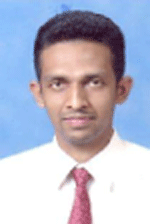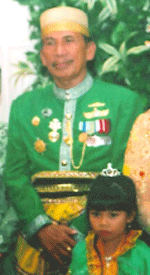Sharif Bangkaya begot two children from her 3rd wife Bae sa Matampay namely, Dakunuq of Malabang and Sharif Laut Buisan. Sharif Laut Buisan was installed as 6th Sultan of Maguindanao in 1597, and was married to the sister of Sultan Batara Shah Tengah of Sulu. Shariff Laut Buisan begot Gayang and Muhammad Dipatuan Kudarat. Gayang was married to the grandson of Dimasangcay Adel- Sharif Matonding whose children reigned as the Sultans and Bai Labi of Lanao while his brother Sharif Muhammad Kudarat was installed as 7th Sultan of Maguindanao in 1619. In 1656 he declared a jihad against the Spanish colonialist. His Sultanate was felt as far as Ternate in Indonesia and Borneo and in fact its power reached the shores of Bohol, Cebu, Panay, Mindoro and Manila in north.
Spanish conquest of Lanao
In 1637 Sebastean Hurtado-de Curcuera decided to send an expedition to subdue the Datus and the people of Lake Lanao. As early as September 1637 he had promised the lake area to the Jesuits, who would get the same the moment it was conquered.
The conquest of the Maranaos was entrusted to Captain Francesco Atienza, the Alcalde Mayor of Caraga. With fifty Spaniards and give hundred Caragans, the captain landed in Bayug, then proceeded to the Maranao territory, reaching the lake on 4 April 1639. There were about 2,000 families or 800 inhabitants. The Spaniards brought with them six collapsible boats that they fitted out in the lake.
The Datus of Lanao initially offered allegiance to the Spaniards. They promised tribute and accepted the missionaries, what appeared ominous to the Spaniards was the movement of inhabitants into the interior at the same time. The Maranaos could easily muster 6,000 warriors from among the four confederation of Lanao. Lack of firearms though was their disadvantage. Governor Al Monte dispatched Major Pedro Fernandez del Rio with seventy Spaniards and 500 Visayans to join with the forces of Atienza. The expedition had to pass through the area of Butig where Sharif Matonding an Iranon Datu married to Gayang, a sister of Sultan Kudarat, engaged the colonizers. After a most difficult passage made by the fierce resistance of Sharif Matonding, Pedro del Rio made it to the shores of the lake where he join the forces of Atienza. In the middle of April Atienza and part of his troops left for Bayug and fortified it with a stockade and sailed for Caraga.
In October of the same year, an additional force of fifty Spaniards and five hundred Boholanos arrived under the command of Captain Pedro Bermudez de Castro who had orders to build a fort in Marawi to establish Spanish sovereignty.
Sultan Kudarat visited his son in laws in Lanao- Balindong Bzar and Dianaton of Butig. He gathered the Datus of Lanao and delivered a speech in this form:
The Maranaos took up arms against the newly built fort. They used indigenous means to get at the fort and set it on fire. Three of the Spanish boats, brought form Bayug were captured. Atienza formed a relief expedition and saved the Spaniards. The Maranao warriors after 29 days of siegeleft their position. Afraid to experience once more the horrors of siege, they proceeded to burn their their own fort and made a retreat back to Iligan. In 1640 Atienza tried once more to conquer the Maranaos. For the second time, the Spaniards burned the fields and retired to the coast, but not without losing some men on the way due to ambushes. The second attempt to colonize and Christianize the Maranaos had utterly failed. In payment for their freedom however, the Maranaos lost their harvest.
Birth of the Sultanates in Lanao
In Lanao, the Maranaos started to be acquainted with the sultanate system in the 15th century thru the influence of Sharif Kabungsuan, who was enthroned as first Sultan of Maguindanao in 1520, In 1640 Balindong Bzar of Masiu became the first Maranao Chieftain enthroned as Sultan, with specific title as Sultan as Sultan Diagaborolah. He was charged to enforce the teaching of Islam and the law and order in Lanao. On the same year Sultan Diagaborolah consulted the seven Maranao Datus on how to govern Lanao. They were Dianton Naib of Butig. Datu Burus of Pagayawan, Datu Ottawa of Ditsaan, Datu Acari of Ramain, Onbaor of Bansaya, Engki-Okoda of Minitupad, Alanake of Baloi. The eight wise man (including Balindong) agreed to create the four confederation of Lanao (Pat a Pangampong a Ranao) composed of the State of Masiu, Butig, Bayabao and Baloi, and on the second level, the 15 Royal houses (Panoroganan) and the 28 legislative body (Pyakambaya ko Taritif). The socio-political system was based on the Taritib, laws, Ijma, customary laws, and adapted practices of the Maranaos. The Pangampong state was further divided into smaller socio-political units. Within the four state is a total 43 Ingud communities classified into 15 Royal Houses (Panoroganans), and 28 supporting Ingud or Legislative Houses called Piyacambaya ko Taritib (Decider of Laws).
The Taritib, an ancient order or law bound together the four states or principality of Lanao into an alliance or confederation and defined their relationships. There is no central, all powerful authority but every state or principality respected the traditional alliance termed Kangiginawai.
One problem that beset the Sultanate of the four confederation of Lanao was the identification of ancestral land area (Kawali) of each State (Pangampong). They were consequently defined by Datu Pascan of Unayan, Datu Popawan of Bayabao, Amiyanon Simban of Masiu and Datu Dilion of Baloi. The agreement known as "Kiatathamana-an" declineated the areas as: Dalama, located in the municipality of Molondo, the boundary between Bayabao and East Masiu; Sawenn Masiu municipality the boundary between East Masiu municipality and East Unayan T Madamba municipality, the boundary between West Unayan and West Masiu; and Bacayawan in Marantao municipality, the boundary between west Masiu and Bayabao. Suprisingly, there is no identified boundary between Bayabao and Baloi but the reason is that both Pangampong lineage come from the same family tree. Under the Kiangginawai (friendship) their boundary need not be established.
In 1754, the maranos kept on increasing their maritime strength and accelerated their attacks on the Spaniards. Leyte and Calamianes bore part of the brunt of their attacks. About nine hundred Maranaos once landed in Albay and captured more than a hundred inhabitants. In Balayan, they looted everything they could lay their hands on. The Maranaos were thus greatly responsible for the abandonment of many settlements in the Visayas and the dislocation of the economic life of thousands of people. The Maranao made these attacks since most of the native troops used against them were Visayans. The events prompted the Spaniards to devise a more elaborate and effective naval system of defense. In 1557, the Iranuns and Maranaos accelerated their attacks on the Spaniards. There were frequent naval encounters between them and the Spaniards. In some of them, according to reports, thousands have perished.
In a span of four years, the Maranao raids on Visayas reduced the number of tributes to the Spanish government by at least 100,000. For example, figures showed that the district of Panay, it paid 1,500 tributes in 1750. By the year 1757 there only 500 tributes paid. In Romblon, the number of tributes went down from 1370 to 995, while in Kalibu (Capiz) it decreased from 1,164 to 549. Many coastal towns were totally destroyed and the visayan population was reduced considerably. In 1759 Datu Aber Palawan and his men attacked the Spanish squadron in the northern part of Mindanao. He was martyred and buried in Radapan, Lanao (now Tarapan, Linamon, Lanao del norte).
Gen. Valeriano Weyler, the Spanish Gov. General decided to deal with the Maranaos in 1889. He ordered his troops to land in Malabang to conquer the unconquered Maranaos. He had 1,242 soldiers in two columns. The first column started from Malabang while the second column started from Higan. (This two-pronged attack on Maranao territory from the northern and western parts of Mindanao was a reminiscent of of the 1639 campaign against Maranaos). After a few bloody clashes, Marawi was occupied on August 19, but not without encountering strong resistance from the Maranaos led by Datu Amai Pakpak. In September 1891, Weyler finally terminated his campaign without actually conquered the Maranaos. In May 15, 1892, Pablo Pastel drafted the blue print for the temporal and spiritual conquest of the Sultanates in Philippines for the gradual reduction of the political and other powers of the Sultans, Datus, Sharif and Pamlitas in such a way that they would all eventually become powerless. The Spaniards considered them as the primary obstacle impeding the rapid progress of the degraded race in its march to civilization. On June 5, the Datus of Lanao cooperated in the fortification of the section around Agus River for their mutual defense. In February 1895, systematic Maranao attacks on the Spanish forst began. As a result, the Spanish invaders launched another Spanish expedition on March 10 of the same year to attack and capture Marawi, once and for all. The march to Marawi commenced. The Spaniards found themselves faced by strong cotta under the command of the same Amai Pakpak. The Maranao warriors fought with equal bravery but lost the war with the martyrdom of Datu Akader Amai Papak, his son, 23 datus and 150 Maranao warriors. The Spaniards lost 194 men. Abot 3,000 Spanish troops, and countless volunteer from Zamboaga, Mizamis and Sibugay were involved. This did not stop the Maranaos to continue fighting. The Spanish garrison in Marawi was in state of siege. Sporadic attacks on the garrison and ambushes become the order of the day. The Maranaos around the lake continued their resistance against the Spaniards even after gunboats were brought to Lake Lanao to launch a campaign against the communities around it. The Spaniards had to withdraw after their defeat in Manila Bay on May 1, 1896.
The American Regime and the Commonwealth
In 1899, the Sultans themselves led their people in fighting both the Spaniards and later, Americans. They all ended as martyrs along with their families and warriors. In 1889, the Americans landed in Malabang and occupied the Spanish camp without much fanfare and named it camp Concuera. Two years later, the Americans proceeded to the lake area but was met by Maranao warriors in Upper Bayang, Amai Barang, Mamarinta, Pitilan Sultan of Bayang and 300 warriors clashed with the Americans in a fierce battle. The Sultan and his men were crushed. The sultan perished but Capt. Vicar also died. (Their camp in Upper Bayang was named after him). In Tugaya Datu Saruang and many others also died fighting against the American forces coming to their place.
During the Commonwealth regime, Amai Manabilang of Marawi challenged the authority of Justice Cayetano Arellano in enforcing the government laws to the Maranaos. He led a campaign that Mindanao should be separated from the Philippines. The policy of attraction of the Americans in Lanao under under General Pershing offered empty promises to the Maranaos who felt that the government deprived them with the continued exercise of their traditional and cultural practices and interference to their religion, customs and traditions.
On March 18, 1935, one hundred twenty Datus of Lanao, with thirty Sultans signed a strongly worded letter, popularly known as "Dansalan Declaration" to U.S President Franklin Roosevelt and the U.S congress asking them that the Filipinos should be granted Independence and the Moro province should also be given their own independence or better left under American rule until such time that they were prepared to grant their independence to be known as Bangsamoro.
The Present Sultanates
The Sultanates in the Philippines at present have legally been disenfranchised and practically reduced to non-entities by a provision in the Philippines constitution prohibiting the grant of a title of nobility to a Filipino citizen. Interestingly, the same constitution provides respect for the local culture, traditions and practices. Many non-Muslims do not realize that the Sultans are not only temporal but also spiritual leaders. They are the symbols not only of their communities but also considered vicegerent followers of Allah in this world. It was the responsibility of the Sultans not only to defend their people and communities but also their religion – Islam. Among the Muslims, there is no way one can separate the Sultanate from their culture, tradition and religious practices. Once the Sultanate is destroyed everything goes along with it. A Muslim is a Muslim because he has his own identity in the Sultanate of which he is part and parcel. Without the Sultanate, he becomes a non-entity, a person with out identity or an anchor much like a rudderless boat being blown away any which way by every passing wind.
This in essence is the heart of the Mindanao problem and why it continues to fester like a wound that has turned cancerous. The government looks at the Mindanao problem as one of economics, peace and order, progress, education, and perhaps implicitly, religion. This may be partly true but the primary factor is the recognition of the rights of the Muslims for self-determination and respect for their own identity as a people with a unique culture and tradition and, for as long as the real solution to this Mindanao problem is not address, the situation will continue to widen. This is where the Royal Sultanate could play a very important role especially because by accepted tradition, his constituents respect and value his authority. For example, in the Preservation of Social Order.
Ø When there is no source of power except the Sultan, the community is stable. The Sultan has influence and command to impose and execute the highly respected Taritib and Ijma.
Ø When a dispute happens and the Sultan is not personally available to settle it, he can simply send his Tobao (scarf Headdress) through his emissary and it would be enough to make the parties stay "in suspended the animation" and wait until he arrives to settle their dispute.
Ø The Sultan has the power to ask anyone within his territory to come for questioning, for punishment if he committed an offense or for anything that is for the interest of his people. He only needs to beat his gong and it is enough for the people to come him.
Ø When a buffalo is stolen by a person from another area, it becomes his duty to recover and restore it to the owner.
Ø When conflicts between Sultanates occur, it was the duty of another Sultan to come and talk to them for peaceful settlement. The common practice used by the Sultan in settling Ridos even until now is tracing the family lineage of the conflicting parties with the ultimate end that both parties will realize that they are relatives either by affinity or by consanguinity. Kambabatabata-a (blood relations) Kapamagongowa (friendship) Kapamagadata (respect), and other relationships of the forefathers are being recalled. In most cases, disputes are resolved with tears flowing from the persons witnessing or present in the scene.
The 16 Ruling Royal Sultanates in Lanao
The original number of the ruling Royal Sultands of Lanao was only fifteen (15). It is now increased to sixteen (16) with the creation of Sultan sa Domalondong sa Butig in Pangampong a Unayan. Hence, it was recently renamed as 16 "Panoroganans of Lanao". A "Pangampong" is a principality where the head is addressed as his Royal Highness (HRH). Since the title of a Sultan becomes now a "common commodity" in Lanao, the 16 Royal Sultans agreed to call themselves as "Panoroganan" instead of "His Royal Highness" in order to be fitting to the Maranao dialect and make them different from the other Sultans in Lanao.
The Panoroganans are the ones entitled to approve or disapprove the Taritib, Ijmas and Adats in their respective Pangampong. This gave them the title as Royal Highness or now localized as "Panoroganans". They also created the 28 "Piakambaya ko Taritib" (ruled by a Sultan but not Royal Sultan) that is seemingly similar to a legislative council or body that formulates the Taritib and Ijma which are distributed by pangampong.
The places under each of the "Pat a Pangmpong a Ranao" are:
- Pangampong a Masiu covers the municipalities of Molondo, Taraka, Tamparan, Masiu, Wato Balindong, Tugaya, Bacolod Kalawi, Madalum n Madamba.
- Pangampong a Unayan covers the south of lake Lanao strictly from the Buldon, Barira, Matanog, Parang of Sharif Kabunsuan province and the long coastal area parallel to Illana Bay going to northern up to Zamboaga, Lanao border. In Lanao del Sur, it include Butiq, Domalondong, Lumayanague, Lumbatan, Bayang, Tubaran, Binidayan, Marogong, Ganassi, Pualas, Madamba, Calanogas, Kapatangan, Balabagan and Malabang. In Lanao del Norte, it includes Kormatan, Lala and Tubod.
- Pangampong Bayabao is presently composed of the Municipalities of Ditsaan Ramain, Bubong, Buadipusa-Buntong, Kapai, Marantao, Saguiran, Maguing, Bumbaran, Wao, Lumba-Bayabao, Poona-Bayabao, Piagapo in Lanao del Sur and the city of Marawi.
- Pangampong a Baloi consists of the municipalities of Pantar, Tangoloan I, Kapai, Baloi, Pantao Ragat, Poona Piagapo, Tangkal, Magsaysay, Kauswagan, Linamon, Bacolod, Maigo and Kolambogan in Lanao del Norte and Iligan City.
THE SIXTEEN ROYAL HOUSES OF LANAO
MASIU
- The Royal House of Masiu
- The Royal House of Datu a Cabugatan
ONAYAN
- The Royal House of Butig
- The Royal House of Pagayawan
- The Royal House of Bayang
- The Royal House of Dumalondong
POONA-BAYABAO
- The Royal House of Bansayan
- The Royal House of Rogan
- The Royal House of Taporog
LUMBA-BAYABAO
- The Royal House of Minitupad
- The Royal House of Borocot
- The Royal House of Bacolod
- The Royal House of Maribo
MALA-BAYABAO
- The Royal House of Ramain
- The Royal House of Ditsaan
BALOI
- The Royal House of Baloi





























